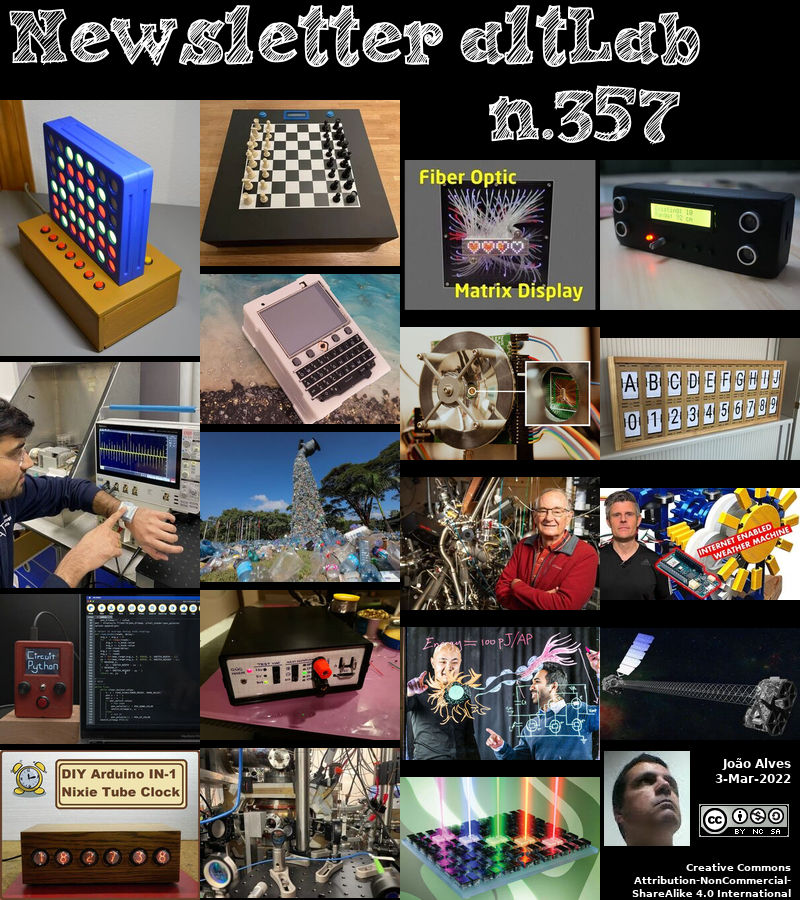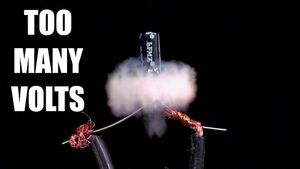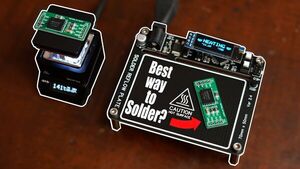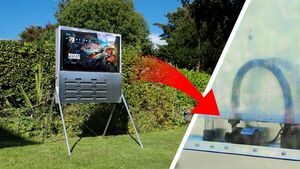2022-03-03 - Nº 357
Editorial
Esta é a Newsletter Nº 357 que se apresenta com o mesmo formato que as anteriores. Se gostar da Newsletter partilhe-a!
Todas as Newsletters encontram-se indexadas no link.
Esta Newsletter tem os seguintes tópicos:
Faz hoje anos que nascia, em 1709, o químico alemão Andreas Marggraf. Ele foi pioneiro no trabalho analítico. Ele utilizou o teste de chama para distinguir entre potassa e refrigerante. Isolou o zinco do seu minério de calamina, e reconheceu a alumina na argila. Em 1747, Marggraf demonstrou que vários tipos de raízes de beterraba continham açúcar e que o açúcar podia ser extraído e cristalizado. O significado prático desta descoberta não foi reconhecido na altura, durante muitos anos foi considerado como um mero exercício laboratorial. Contudo, algumas décadas mais tarde, levou ao desenvolvimento da indústria açucareira moderna, quando Franz Karl Achard, um aluno de Marggraf, atacou o problema do cultivo da beterraba. Achard conseguiu extrair açúcar da beterraba a uma escala comercial.
Faz também hoje anos que nascia, em 1838, o astrónomo matemático norte-americano George William Hill. Ele foi considerado por muitos dos seus pares como o maior mestre da mecânica celestial do seu tempo. Hill juntou-se ao Gabinete do Almanaque Náutico em 1861. Ele calculou a órbita da lua enquanto fazia contribuições originais para o problema dos três corpos. Introduziu infinitos determinantes, um conceito que mais tarde encontrou aplicação em muitos campos da matemática e da física. Quando Simon Newcomb assumiu o Almanaque Náutico em 1877 e começou uma recomputação completa de todos os movimentos do sistema solar, a Hill foi atribuído o difícil problema das órbitas de Júpiter e Saturno. Após completar o enorme trabalho em dez anos, regressou à sua quinta, onde continuou a sua pesquisa em mecânica celestial.
Faz igualmente hoje anos que nascia, em 1845, o matemático russo-alemão Georg Cantor. Ele criou a teoria moderna dos conjuntos e a ampliou para dar o conceito de números transfinitos, com classes de números cardinais e ordinais. Embora o primeiro trabalho de Cantor se tenha preocupado com as séries de Fourier, a sua reputação assenta na sua contribuição para a teoria dos conjuntos transfinitas. Começou com a definição de conjuntos infinitos proposta por Dedekind em 1872: um conjunto é infinito quando é semelhante a uma parte própria de si mesmo. Os conjuntos com esta propriedade, tais como o conjunto de números naturais, são ditos "denumeráveis" ou "contabilizáveis".
Faz também hoje anos que nascia, em 1847, o inventor escocês-americano Alexander Graham Bell. Ele é o inventor do telefone. A carreira de Bell foi influenciada pelo seu avô (que publicou The Practical Elocutionist and Stammering and Other Impediments of Speech), pelo seu pai (cujo interesse era a mecânica e os métodos de comunicação vocal) e pela sua mãe (que era surda). Quando adolescente, Alexandre ficou intrigado com os escritos do físico alemão Hermann Von Helmholtz, On The Sensations of Tone. Aos 23 anos, mudou-se para o Canadá. Em 1871, Bell começou a dar instrução em Discurso Visível na Escola para Surdos Mudos de Boston. Este contexto estabeleceu o seu curso no desenvolvimento da transmissão de voz sobre fios. Co-fundou a Bell Telephone Co em 1877. Com o seu sogro, restabeleceu a revista Science (1882)".
Faz igualmente hoje anos que nascia, em 1879, o bioquímico norte-americano Elmer McCollum. Ele criou o sistema de letras de vitaminas. Descobriu as vitaminas A, B e trabalhou com outros sobre a vitamina D. Realizou um extenso trabalho de investigação em nutrição e crescimento. Foi o primeiro nos Estados Unidos a estabelecer uma colónia de ratos brancos como animais de laboratório a ser objecto das suas experiências nutricionais. Nos anos 1910, reconheceu que uma dieta saudável exigia certas gorduras, e nomeou o componente essencial "lipossolúvel A", por oposição a outro que nomeou "hidrossolúvel B". Embora no início pensasse que cada um era um único composto, mais tarde mostrou que eram de facto complexos. Investigou como certos minerais eram importantes como nutrientes, incluindo cálcio, fósforo, flúor, manganês e zinco.
Faz também hoje anos que nascia, em 1898, o matemático austro-alemão Emil Artin. Ele trabalhou na teoria do número algébrico, deu uma grande contribuição para a teoria de campo, e declarou uma lei de reciprocidade que incluía todas as leis de reciprocidade anteriormente conhecidas (1927). Trabalhou também na teoria das tranças (1925), e em anéis com a condição mínima sobre ideais certos, agora chamados anéis Artinianos (1944). Artin tem a distinção de resolver (1927) um dos famosos 23 problemas anteriormente colocados por Hilbert em 1900.
Por fim, faz hoje anos que nascia, em 1918, o bioquímico norte-americano Arthur Kornberg. Ele partilhou o Prémio Nobel da Fisiologia ou Medicina de 1959 (com Severo Ochoa) pela "descoberta dos mecanismos na síntese biológica do ácido desoxirribonucleico" Kornberg mostrou não só como as moléculas de ADN são duplicadas tanto na natureza dentro das células bacterianas, mas também isolou a primeira enzima polimerizadora de ADN (1958), e reproduziu o processo no tubo de ensaio. A sua investigação incluiu o estudo dos ácidos nucleicos que controlam a hereditariedade em animais, plantas, bactérias e vírus".
A 3 de Março de 1969 era lançada a Apollo 9. Voando em órbita terrestre baixa, foi a segunda missão Apollo tripulada que os Estados Unidos lançaram através de um foguete Saturn V, e foi o primeiro voo da nave espacial Apollo completa: o módulo de comando e serviço (CSM) com o Módulo Lunar (LM). A missão foi pilotada para qualificar o LM para operações de órbita lunar em preparação para a primeira aterragem lunar, demonstrando os seus sistemas de propulsão de descida e subida, mostrando que a sua tripulação podia pilotá-lo de forma independente, e depois encontrar-se e atracar novamente com o CSM, como seria necessário para a primeira aterragem lunar da tripulação. Outros objectivos do voo incluíram o disparo do motor de descida LM para impulsionar a pilha da nave espacial como modo de apoio (como seria exigido na missão Apollo 13), e a utilização da mochila do sistema portátil de suporte de vida fora da cabine LM. A missão foi um sucesso completo.
Foi também nesta data, em 2005 que o Virgin Atlantic GlobalFlyer terminou o primeiro voo de circunavegação em 2 dias, 19 horas, 1 minuto e 46 segundos. A partir de 2019, esta é a viagem mundial mais rápida da sua classe a uma velocidade de 550,78 km/h. A distância voada foi determinada em 36.912 quilómetros (22.936 mi), apenas 125 quilómetros (78 mi) acima da distância mínima exigida. Tratou-se do primeiro voo de circunavegação sem paragens solo.
Na Newsletter desta semana apresentamos diversas noticias, artigos científicos, projetos de maker e alguns vídeos interessantes.
 João Alves ([email protected])
João Alves ([email protected])
O conteúdo da Newsletter encontra-se sob a licença  Creative Commons Attribution-NonCommercial-ShareAlike 4.0 International License.
Creative Commons Attribution-NonCommercial-ShareAlike 4.0 International License.
Outras Notícias

NASA’s NuSTAR Makes Illuminating Discoveries With ‘Nuisance’ Light
"A design quirk in the X-ray observatory has made it possible for astronomers to use previously unwanted light to study even more cosmic objects than before. For almost 10 years, NASA’s NuSTAR (Nuclear Spectroscopic Telescope Array) X-ray space observatory has been studying some of the highest-energy objects in the universe, such as colliding dead stars and enormous black holes feasting on hot gas. During that time, scientists have had to deal with stray light leaking in through the sides of the observatory, which can interfere with observations much like external noise can drown out a phone call. But now team members have figured out how to use that stray X-ray light to learn about objects in NuSTAR’s peripheral vision while also performing normal targeted observations. This development has the potential to multiply the insights that NuSTAR provides. A new science paper in the Astrophysical Journal describes the first use of NuSTAR’s stray light observations to learn about a cosmic object – in this case, a neutron star." [...]
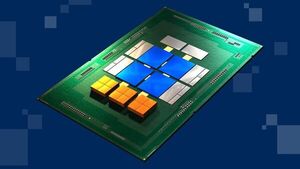
Fostering a Chiplet Ecosystem for the Future of Moore’s Law
"To satisfy the ever-increasing demand for more computing power, Intel and many of our colleagues in the semiconductor industry have come to the same conclusion: The future of chip innovation lies in moving to modular designs based on “chiplet” building blocks, essentially moving from system-on-chip (SoC) to System-on-Package (SoP) chip architectures. The feasibility of implementing complex systems on monolithic dies is reaching its physical and economic limits. Gordon Moore predicted this “Day of Reckoning” in his seminal 1965 white paper, “Cramming More Components Onto Integrated Circuits,” writing that as chip density and complexity progressed, eventually “it may prove to be more economical to build large systems out of smaller functions, which are separately packaged and interconnected.” The industry’s increasing adoption of modular semiconductor design takes us into the realm of SoP, giving architects incredible flexibility to mix and match the best IP and process technologies for any given product. Intel has been shipping chiplet-based designs since 2016 with Intel® Stratix®10 FPGAs. Modular design is also a key component of our IDM 2.0 strategy as we use internal and external foundry resources to build our products while offering our foundry services to the industry. Later this year, our customers will see our next-generation tile-based processors in the Sapphire Rapids and Ponte Vecchio SoCs." [...]
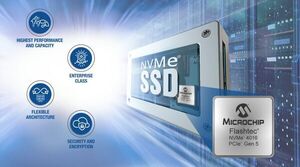
Microchip Introduces Industry’s Highest-Performance 16-Channel PCIe® Gen 5 Enterprise NVMe® SSD Controller
"The Flashtec® NVMe 4016 controller enables unparalleled performance and a rich "cloud-ready" feature set including industry-leading security features. As data processing requirements continue to evolve, cloud-scale infrastructure requires solutions that maximize bandwidth, minimize latency and are optimized for efficient resource utilization. Microchip Technology Inc. (Nasdaq: MCHP) today announced the newest member of the Flashtec® controller family, the NVMe® 4016 SSD controller. As the industry’s highest-performing PCIe® Gen 5 NVMe SSD controller, the Flashtec NVMe 4016 controller addresses the market demand for high-reliability, high-performance Solid-State Drives (SSDs) delivering greater than 14 GB per second throughput and over 3 million IOPS. With advanced Credit Management technology, this next-generation controller offers the stringent Quality of Service (QoS) required by today’s cloud-focused data center applications. “Microchip is proud to announce the next generation of our Flashtec NVMe controller product line." [...]

Automotive Door-Zone and Rear-Window Controller from STMicroelectronics Adds Power-Trunk/Tailgate Capability
"STMicroelectronics is increasing the integration of automotive body electronics with the L99DZ200G door-zone system IC, which enables a single-chip front-drives-rear setup managing a front-door window, mirror, and lighting as well as the rear-window lift. The rich set of features delivers an equally rich set of benefits including lower system quiescent current, greater reliability, faster assembly, reduced bill of materials, and shorter development time. The L99DZ200G contains two H-bridge gate drivers, a gate driver for an external MOSFET to control mirror heating, a control block and high-side driver for electro-chromic mirror dimming, and five LED high-side drivers. Three of the high-side drivers can operate in constant-current mode to power lighting modules that have high input capacitance. The other two high-side drivers are suitable for controlling ordinary LEDs. With its two H-bridge drivers, the L99DZ200G can control two spindle motors simultaneously and handle an additional cinch motor to close a powered tailgate or trunk." [...]

Renesas Pioneers RISC-V Technology With RZ/Five General-Purpose MPUs Based on 64-Bit RISC-V CPU Core
"Renesas Electronics Corporation (TSE:6723), a premier supplier of advanced semiconductor solutions, today announced the RZ/Five general-purpose microprocessor units (MPUs) built around a 64-bit RISC-V CPU core. The RZ/Five employs the Andes AX45MP, based on the RISC-V CPU instruction set architecture (ISA). The RZ-Five augments Renesas’ previously available Arm® CPU core–based MPUs, expanding customer options and providing more flexibility in the product development process. “I am delighted that Renesas is among the first to announce a general-purpose MPU built around a 64-bit RISC-V CPU core from Andes,” said Hiroto Nitta, Senior Vice President and Head of SoC Business in the IoT and Infrastructure Business Unit at Renesas. “With the introduction of the RZ/Five MPUs along with ecosystem support, Renesas is taking the lead in providing RISC-V solutions ahead of the market.” “RZ/Five is the first general-purpose MPU on the market to be built around a 64-bit RISC-V core from Andes,” said Frankwell Lin, Chairman and CEO at Andes Technology Corp. “Andes has collaborated with Renesas first on the 32-bit RISC-V core and now on the 64-bit AX45MP, and I anticipate that this development will lead to the early adoption of customers’ devices in the global market built with Andes’ advanced RISC-V processor families.” Ideal for IoT Endpoint Devices Demand is increasing for IoT endpoint devices, such as gateways for solar inverters or home security systems, to collect sensor data and connect to servers or to the cloud. In response to this need, RZ/Five is optimized to provide the performance and peripheral functions required of IoT endpoint devices." [...]

Micron Delivers World’s Most Advanced 176-Layer NAND Data Center SSD
"Micron Technology, Inc. (Nasdaq: MU), today announced it is sampling the world’s first vertically-integrated 176-layer NAND solid-state drive (SSD) for the data center. The Micron 7450 SSD with NVMeTM delivers quality-of-service (QoS) latency at or below 2 milliseconds (ms),1 a wide capacity range and the broadest set of form factors available to meet the needs of the most demanding data center workloads. This new data center SSD includes Micron’s industry-leading NAND, which contains 176 layers of storage cells and proven CMOS-under-the-array technology, to deliver an ultraefficient design. Integrated with Micron’s own DRAM, internally developed SoC and associated firmware, this vertically integrated SSD enables the company to rapidly respond to customer needs in the market and support strengthened device security. "We're launching the Micron 7450 SSD at the same time PCIe Gen4 is becoming the most widely adopted SSD interface in servers,” said Jeremy Werner, corporate vice president and general manager of Micron’s Storage Business Unit. “This product delivers the world’s most advanced NAND in a data center SSD well ahead of the industry and, importantly, brings consistent, reliable latencies below 2 milliseconds, critical to enabling quality of service in scale-out data center workloads.” Significantly Reduced Latency The 7450 SSD achieves latency at or below 2 ms for 99.9999% QoS in common, mixed, random workloads1— driving up performance in databases such as Microsoft SQL Server, Oracle, MySQL, RocksDB, Cassandra and Aerospike, among others." [...]
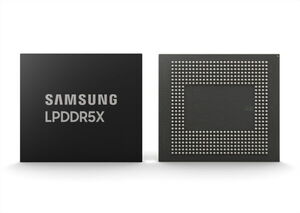
Samsung’s LPDDR5X DRAM Validated for Use With Qualcomm Technologies’ Snapdragon Mobile Platforms
"Featuring approximately 1.2x processing speed and 20% less power consumption, Samsung’s LPDDR5X DRAM will boost the performance of ultra-high-res video recording and AI features in next-generation flagships The LPDDR5X solution will extend the use of high-performance, low-power memory, beyond conventional mobile applications to automotive and data centers Samsung Electronics, the world leader in advanced memory technology, today announced that Qualcomm Technologies, Inc. has validated Samsung’s 14-nanometer (nm) based 16-gigabit (Gb) Low Power Double Data Rate 5X (LPDDR5X) DRAM for use on Qualcomm Technologies’ Snapdragon® mobile platforms. Since developing the industry’s first 14nm-based LPDDR5X DRAM last November, Samsung has worked closely with Qualcomm Technologies to optimize its 7.5 gigabit-per-second (Gbps) LPDDR5X for use with Snapdragon mobile platforms. Delivering about 1.2 times faster speed than the 6.4Gbps LPDDR5 deployed in today’s premium smartphones, Samsung’s LPDDR5X is expected to boost the performance of ultra-high-resolution video recording as well as AI features such as voice recognition, image recognition and natural language processing in next-generation smartphones. Furthermore, by adopting advanced circuit designs as well as dynamic voltage and frequency scaling (DVFS), LPDDR5X power consumption can be reduced by approximately 20%. “The successful validation of our LPDDR5X solution for Qualcomm Technologies’ Snapdragon mobile platforms is a testament to our leadership in DRAM technology,” said Jinman Han, Corporate Executive Vice President and Head of Memory Global Sales & Marketing at Samsung Electronics. “We expect applications for this high-performance, low-power memory to extend beyond smartphones into the data center, PC and automotive, enabling more devices and systems to run with greater efficiency.” “Qualcomm Technologies is an industry leader in enabling and adopting the latest LPDDR DRAM specifications." [...]

Intel Introduces vPro Platform for Revolutionary Business Performance
"Today, Intel announced the latest Intel vPro platform, powered by 12th Gen Intel® Core™ – which delivers the world’s best processors for business productivity1. Built for business, the Intel vPro platform with 12th Gen Intel Core processors provides leading productivity and the highest performance and most comprehensive platform security for all businesses. How It Works: With over 15 years of innovation, Intel vPro delivers a complete platform portfolio to meet the technology demands and computing options to empower businesses of all sizes. Intel vPro® Enterprise for Windows is the full-featured commercial platform focused on large enterprises and managed businesses. It features a comprehensive set of technologies to help businesses stay ahead of security threats. - Intel vPro® Essentials extends security and device management capabilities previously targeting large enterprise to the small and medium-size business segment." [...]
Ciência e Tecnologia
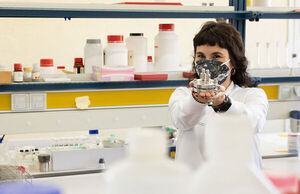
New developments designed to increase electric vehicle range
"The UPV/EHU-University of the Basque Country is proposing that caesium cations be used in sodium-air batteries A multidisciplinary team of UPV/EHU chemists and physicists in collaboration with CIC energiGUNE has shown that adding a caesium salt to the electrolyte of sodium-air (Na-O2) batteries significantly increases the life of the device, which would have a positive impact on electric vehicle range. The work has been published in the prestigious international journal Advanced Energy Materials. Metal-air batteries offer a promising technology to succeed today's conventional lithium-ion batteries. One of the most significant advantages of metal-air batteries is that they have a higher energy density than lithium-ion ones, so batteries of this type would give the car an increased range. They would enable range, which is one of the major concerns of car manufacturers, to be considerably minimised. "Metal-air batteries are among the most sustainable batteries because the materials used are more environmentally friendly." [...]

Surrey unveils energy-harvesting wearable device made from recycled waste
"Scientists have unveiled a wrist device made from discarded paper wipes and plastic cups that runs on energy harvested by the wearer's movements. The prototype device can transmit Morse code, and the team is now focusing on plans to use this technology in smart watches. Dr Bhaskar Dudem, project lead and Research Fellow at the University of Surrey's Advanced Technology Institute (ATI), said: "It won't be long until we have to ask ourselves which of the items we own are not connected to the internet. However, the current internet-of-things (IoT) revolution highlights the simple fact that our planet doesn't have the raw resources to continue to make these devices which are in such high demand. "Our research demonstrates that there is a path to creating sustainable technology that runs on electricity powered by us, the users of that technology." Surrey's device is 'self-powered' thanks to materials that become electrically charged after they come into contact with one another." [...]
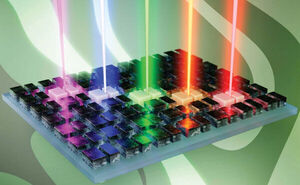
ITMO Researchers Discover New Properties of Metasurfaces Thanks to Ultrashort Pulse Lasers
"A group of researchers from ITMO University, the Australian National University, and the Friedrich Schiller University Jena (Germany) has for the first time demonstrated effective generation of higher harmonics in silicon metasurfaces. This result was achieved due to resonant states with long lifietimes. The new discovery brings closer the creation of attosecond radiation sources based on semiconductor nanostructures. Ultrashort pulse lasers which earned their pioneers the Nobel Prize in Physics in 2018 make it possible to excite and explore very rapid processes in nature and matter. This opens new horizons for understanding ultrafast physics and faster information recording. High harmonics generation is a nonlinear optical process of photon interaction with nonlinear media that results in the generation of radiation with a frequency that is multiplied by a corresponding integer number (e.g., 5th harmonic generation = 5 times the frequency of the initial photon)." [...]

Coproducing water and electricity powers crop growth
"A solar-driven system to generate electricity and produce water for crops in arid areas may help a decentralized approach to food, water and energy security. The major challenge for food production in arid and semiarid areas remains the lack of water resources. While there is no shortage of sunlight to power solar panels in these regions, photovoltaic cells also generate vast amounts of heat that reduce their energy efficiency. KAUST researchers are addressing these issues with an integrated approach that uses atmospheric water vapor to produce fresh water for crop growth and also to generate cooling power for PV cells, thus improving their performance. Postdoc Renyuan Li and colleagues have invented a novel system that can coproduce water, electricity and crops in most regions, including arid and semiarid areas. “We believe this system can contribute to the global water-energy-food nexus, generate electricity and produce water for remote and off-grid communities," says Li." [...]
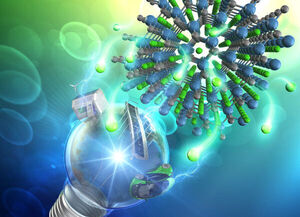
New Electrode on Board: Zinc Blende Type β-SiC Anode Materials for Lithium-ion Batteries
"Scientists present a simple methodology for the synthesis of novel β-SiC nanoparticle-based anode materials for lithium-ion batteries β-Silicon carbide (SiC)-based anode materials have recently garnered attention as a promising alternative to graphite in lithium-ion batteries (LIB). However, the conventional methods of preparation demand expensive equipment and involve complex multistep procedures. Scientists at the Japan Advanced Institute of Science and Technology developed a facile, cost-effective, and scalable technique for the synthesis of β-SiC nanoparticles. Further, combination of β-SiC and N-doped carbon was found to be highly efficient to enhance discharging capacity. The high-performance material allows easy integration with commercial LIB systems ensuring a wide range of energy applications. Lithium-ion batteries (LIBs), known for their longevity, excellent charge storage characteristics, high energy density, and high operating voltage, have become the cornerstone of portable electronics, electronic vehicles, and the alternate energy economy." [...]

Researchers Devise Attack for Stealing Data During Homomorphic Encryption
"A vulnerability in a Microsoft crypto library gives attackers a way to figure out what data is being encrypted in lockpicker-like fashion. Researchers at North Carolina State University have developed what they claim is the first successful side-channel attack on an emerging security technology called homomorphic encryption, which allows operations to be performed on encrypted data. The technique will be presented on March 23 at the virtual DATE22 conference and involves a way to steal data even while it is in the process of being homomorphically encrypted. The lead author on the paper is Furkan Aydin, a doctoral student at NC State, and it was co-authored by three other researchers at the university. Aydin Aysu, assistant professor at NC State's electrical and computer engineering department, likens the attack to lock-pickers in movies who listen to a safe to crack it. "We do the same on computer hardware," Aysu says." [...]
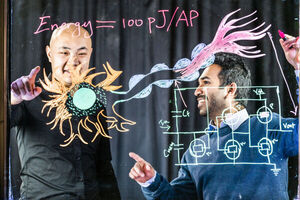
Building artificial nerve cells
"For the first time, researchers demonstrate an artificial organic neuron, a nerve cell, that can be integrated with a living plant and an artificial organic synapse. Both the neuron and the synapse are made from printed organic electrochemical transistors. On connecting to the carnivorous Venus flytrap, the electrical pulses from the artificial nerve cell can cause the plant’s leaves to close, although no fly has entered the trap. Organic semiconductors can conduct both electrons and ions, thus helping mimic the ion-based mechanism of pulse (action potential) generation in plants. In this case, the small electric pulse of less than 0.6 V can induce action potentials in the plant, which in turn causes the leaves to close. “We chose the Venus flytrap so we could clearly show how we can steer the biological system with the artificial organic system and get them to communicate in the same language”, says Simone Fabiano, associate professor and principal investigator in organic nanoelectronics at the Laboratory of Organic Electronics, Linköping University, Campus Norrköping." [...]

NGI uses twist to engineer 2D semiconductors with built-in memory functions
"A team of researchers at The University of Manchester’s National Graphene Institute (NGI) and the National Physical Laboratory (NPL) has demonstrated that slightly twisted 2D transition metal dichalcogenides (TMDs) display room-temperature ferroelectricity. This characteristic, combined with TMDs’ outstanding optical properties, can be used to build multi-functional optoelectronic devices such as transistors and LEDs with built-in memory functions on nanometre length scale. Ferroelectrics are materials with two or more electrically polarisable states that can be reversibly switched with the application of an external electric field. This material property is ideal for applications such as non-volatile memory, microwave devices, sensors and transistors. Until recently, out-of-plane switchable ferroelectricity at room temperature had been achieved only in films thicker than 3 nanometres. 2D heterostructures Since the isolation of graphene in 2004, researchers across academia have studied a variety of new 2D materials with a wide range of exciting properties." [...]

Metasurface-Based Antenna Turns Ambient Radio Waves into Electric Power
"Researchers have developed a new metasurface-based antenna that represents an important step toward making it practical to harvest energy from radio waves, such as the ones used in cell phone networks or Bluetooth connections. This technology could potentially provide wireless power to sensors, LEDs and other simple devices with low energy requirements. “By eliminating wired connections and batteries, these antennas could help reduce costs, improve reliability and make some electrical systems more efficient,” said research team leader Jiangfeng Zhou from the University of South Florida. “This would be useful for powering smart home sensors such as those used for temperature, lighting and motion or sensors used to monitor the structure of buildings or bridges, where replacing a battery might be difficult or impossible.” In the journal Optical Materials Express, the researchers report that lab tests of their new antenna showed that it can harvest 100 microwatts of power, enough to power simple devices, from low power radio waves. This was possible because the metamaterial used to make the antenna exhibits perfect absorption of radio waves and was designed to work with low intensities. “Although more work is needed to miniaturize the antenna, our device crosses a key threshold of 100 microwatts of harvested power with high efficiency using ambient power levels found in the real world,” said Clayton Fowler, the team member who fabricated the sample and performed the measurements." [...]
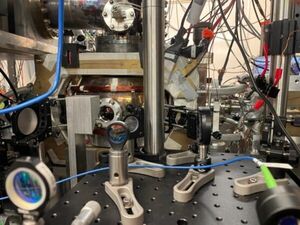
Stanford researchers showcase a new level of control over how atoms interact
"A new study demonstrates – for the first time – how to versatilely program atoms to share information regardless of their spatial location, opening paths forward in fundamental physics and advanced computing. In a new study, Stanford researchers demonstrate how to manipulate atoms so they interact with an unprecedented degree of control. Using precisely delivered light and magnetic fields, the researchers programmed a straight line of atoms into treelike shapes, a twisted loop called a Möbius strip and other patterns. These shapes were produced not by physically moving the atoms, but by controlling the way atoms exchange particles and “sync up” to share certain properties. By carefully manipulating these interactions, researchers can generate a vast range of geometries. Importantly, they found that atoms at the far ends of the straight line could be programmed to interact just as strongly as the atoms located right next to each other at the center of the line." [...]
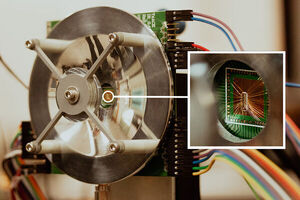
New Imager Microchip Helps Devices Bring Hidden Objects to Light
"Researchers from The University of Texas at Dallas and Oklahoma State University have developed an innovative terahertz imager microchip that can enable devices to detect objects and create images through obstacles that include fog, smoke, dust and snow. The team is working on a device for industrial applications that require imaging up to 20 meters away. The technology could also be adapted for use in cars to help drivers or autonomous vehicle systems navigate through hazardous conditions that reduce visibility. On an automotive display, for example, the technology could show pixelated outlines and shapes of objects, such as another vehicle or pedestrians. “The technology allows you to see in vision-impaired environments. In industrial settings, for example, devices using the microchips could help with packaging inspections for manufacturing process control, monitoring moisture content or seeing through steam." [...]
Surprising Semiconductor Properties Revealed with Innovative New Method
"A research team probing the properties of a semiconductor combined with a novel thin oxide film have observed a surprising new source of conductivity from oxygen atoms trapped inside. Scott Chambers, a materials scientist at the Department of Energy’s Pacific Northwest National Laboratory, reported the team’s discovery at the Spring 2022 meeting of the American Physical Society. The research finding is described in detail in the journal Physical Review Materials. The discovery has broad implications for understanding the role of thin oxide films in future semiconductor design and manufacture. Specifically, semiconductors used in modern electronics come in two basic flavors—n-type and p-type—depending on the electronic impurity added during crystal growth. Modern electronic devices use both n- and p-type silicon-based materials." [...]
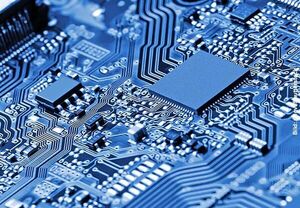
Spintronics: Innovative crystals for future computer electronics
"Computer chips and storage elements are expected to function as quickly as possible and be energy-saving at the same time. Innovative spintronic modules are at an advantage here thanks to their high speed and efficiency, as there is no lossy electrical current, rather the electrons couple with one another magnetically – like a series of tiny magnetic needles which interact with almost no friction loss. A team of scientists involving Goethe University Frankfurt and the Fritz Haber Institute in Berlin has now found promising properties with crystals grown from rare-earth atoms, which offer hope on the long path towards usage as spintronic components. While modern computers are already very fast, they also consume vast amounts of electricity. For some years now a new technology has been much talked about, which although it is still in its infancy could one day revolutionise computer technology – spintronics. The word is a portmanteau meaning “spin” and “electronics”, because with these components electrons no longer flow through computer chips, but the spin of the electrons serves as the information carrier." [...]
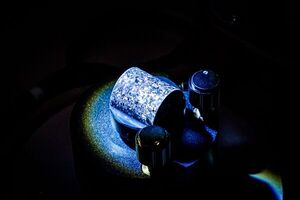
Quick way to check quality of 3d-printed alloys
"Scientists from NTU Singapore, have developed a fast and low-cost imaging method that can analyse the structure of 3D-printed metal parts and offer insights into the quality of the material. Most 3D-printed metal alloys consist of a myriad of microscopic crystals, which differ in shape, size, and atomic lattice orientation. By mapping out this information, scientists and engineers can infer the alloy’s properties, such as strength and toughness. This is similar to looking at wood grain, where wood is strongest when the grain is continuous in the same direction. This made-in-NTU technology could benefit, for example, the aerospace sector, where low-cost, rapid assessment of mission critical parts — turbine, fan blades and other components — could be a gamechanger for the maintenance, repair and overhaul industry. In comparison to the current gold standard of using a scanning electron microscope that is expensive and is time-consuming, this fast and easy method of analysing metal alloys requires only 15 minutes and costs only a fraction of the price." [...]

Researchers show how to make ‘computer’ out of liquid crystals
"Breakthrough at UChicago could pave the way for applications in robotics, computing using soft materials Researchers with the University of Chicago Pritzker School of Molecular Engineering have shown for the first time how to design the basic elements needed for logic operations using a kind of material called a liquid crystal—paving the way for a completely novel way of performing computations. The results, published Feb. 23 in Science Advances, are not likely to become transistors or computers right away, but the technique could point the way towards devices with new functions in sensing, computing and robotics. “We showed you can create the elementary building blocks of a circuit—gates, amplifiers, and conductors—which means you should be able to assemble them into arrangements capable of performing more complex operations,” said Juan de Pablo, the Liew Family Professor in Molecular Engineering and senior scientist at Argonne National Laboratory, and the senior corresponding author on the paper. “It’s a really exciting step for the field of active materials.” The details in the defects The research aimed to take a closer look at a type of material called a liquid crystal. The molecules in a liquid crystal tend to be elongated, and when packed together they adopt a structure that has some order, like the straight rows of atoms in a diamond crystal—but instead of being stuck in place as in a solid, this structure can also shift around as a liquid does. Scientists are always looking for these kinds of oddities because they can utilize these unusual properties as the basis of new technologies; liquid crystals, for example, are in the LCD TV you may already have in your home or in the screen of your laptop." [...]

How to convert carbon dioxide into the building blocks for fuel
"Alex van de Steeg mapped CO2 plasmas to figure out the reactions at play when CO2 splits into other molecules at temperatures hotter than the surface of the sun. As part of the goals of the Paris Climate Accords, we must decrease fossil fuel-related CO2 in the atmosphere. One way to do this, and at the same time produce sustainable fuels, is to split CO2 molecules into carbon monoxide (CO) and oxygen. The CO could then be used to make fuels for the aviation and manufacturing industries. For his PhD research, Alex van de Steeg studied in detail how high-temperature plasmas split CO2 into CO. His results suggest that using plasmas is an appealing way to make the building blocks for sustainable fuels in the future. Van de Steeg obtained his PhD cum laude at the department of Applied Physics on March 1st." [...]

Green chemistry: Scientists develop new process for more eco-friendly liquid crystals
"Liquid crystals could soon be produced more efficiently and in a more environmentally friendly way. A new process has been developed by researchers at Martin Luther University Halle-Wittenberg (MLU) in Germany, Bangalore University in India and Cairo University in Egypt. Compared to conventional methods, it is faster, more energy-efficient and promises a high yield as the team reports in the "Journal of Molecular Liquids". Liquid crystals are used in most smartphone, tablet and computer displays. The production of liquid crystals is a complex process with many intermediate steps. "Often it requires various solvents and expensive catalysts," says Dr Mohamed Alaasar, a chemist at MLU." [...]
Projetos Maker
Diversos Projetos interessantes.
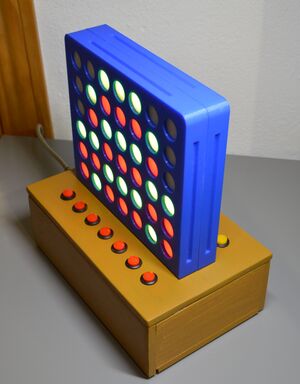
Electronic Game - Four in a Row
"This project was created by Cristhian López Reyes, Luis Miguel Campos García and Juan Pablo Páez Guerrero, students of 'Creative Electronics', a Beng Electronics Engineering module at the University of Málaga, School of Telecommunications. We would like to introduce you our electronic 4 in a row project which is controlled by Arduino, based on NeoPixel library from the Adafruit company. As we consider it is a fun and dynamic idea for both adults and children, it was chosen by our team. Best of all, you can build the project on your own, autonomously. What is more, materials can be changed. All in all, others materials can be chosen in case if 3D printing is not an option." [...]
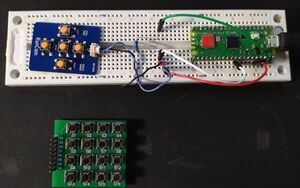
handy-clicker
"Circuitpython HID emulator device with smart home functions Handy clicker is raspberry pi pico based device with additional keyboard for fpv cameras. How does it work? OSD camerea pilot on circuitboard got different resistors combined with buttons. So if you push "UP" button there occour e.g. 6000 m ohm when down e.g 2000 m ohm. I connected keyboard to pico pin's no 26 which is used to read analog values." [...]
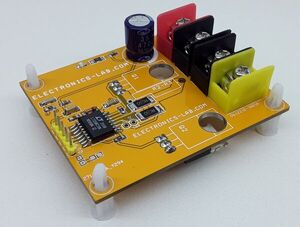
High Current Half-Bridge with Over Current Shutdown
"The project presented here is a versatile high voltage Half-Bridge with Over-Current Shutdown. The project is built using LT1158 IC from Analog Devices. It is suited for many applications as listed below. A single input pin on the LT1158 synchronously controls two N-channel power MOSFETs IRF3710 in a totem pole configuration. Unique adaptive protection against shoot-through currents eliminates all matching requirements for the two MOSFETs. This greatly eases the design of high-efficiency motor control and switching regulator systems." [...]
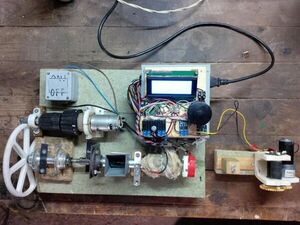
Recycle Plastic Into 3D Printer Filament at Home
"3D printing is very exciting technology as it reaches the home scale but using brand new filament was not acceptable to me as it would just increases the plastic waste amount on the planet. I started to look for a way to turn plastic scraps around me into usable 3D printer filament... On the web I could find many plastic extruders and recyclers but they exceeded my budget so I decided to build my own process. My current system costs less than 100 with half of the parts taken from scrap. The process consists in sorting and cleaning plastic pieces taken from defective household appliances, grinding them to small granules, and feed those granules to a home made small extrusion line. After a quick post-processing step, the output filament can be used by a 3D printer to print new objects. All my work is widely inspired by others projects on the web : Filastruder, Lyman filament extruder, Precious Plastic project and various YouTube or instructables.com contributions." [...]

Double Lithium-Ion/Lithium-Polymer USB Type-C Charger
"Double Lithium-Ion/Lithium-Polymer USB Type-C Charger Nowadays, Lithium batteries are used extensively in portable devices, such as cellphones, laptop computers, electronic gadgets, … etc. There is a standard industry-defined procedure (cycle) for charging the lithium-ion/lithium-polymer batteries, otherwise, the lifetime of the batteries is reduced significantly or even they might explode and catch fire. As a basic rule of thumb, a lithium battery should be charged at the rate of 0.5C to 1C. In this article/video, I have introduced a universal double lithium battery charger that the charging current (C rate) can be adjusted simply by changing a resistor value. You just need a 5V power source (such as a mobile charger) and a USB Type-C cable. To design the schematic and PC, I used Altium Designer 22 and the SamacSys component libraries (Altium Plugin)." [...]
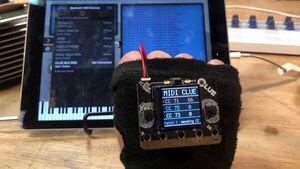
CLUE BLE MIDI Glove
"Send wireless MIDI continuous controller (CC) messages over the air to your favorite BLE synthesizer or synth app on iOS or mac os! This project uses the CLUE's built-in accelerometer and proximity sensor to send three different CC signals as you tilt and roll your hand. Use the CLUE's TFT screen, buttons, and touch pads to select different CC numbers, and even pause/restart sending data while maintaining the BLE MIDI connection. You can also change the sound of your synth entirely at the tap of a CLUE touchpad by sending Bank/Preset Program Change messages. " [...]

Air Football
"As a part of my exchange programme in Creative Design & Technology at Saxion University in the Netherlands, I created an Air Football. The product is a result of project on 8 weeks, and I chose to make my showcase as a complete DIY tutorial which ended up in this post. The project's purpose was to extend both creative and technical skills which I did by ex. researching, ideating, developing concepts, user testing, learning SolidWorks, learning how to work with a Nextion display, and furthermore extending my skills in 3D printing, laser cutting, programming in Arduino IDE, and much more. The product has still place for improvement. An example of this is the usage of delay in the Arduino code which caused that the light show and animation can't be displayed simultaneously." [...]
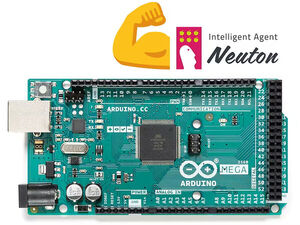
Gesture Recognition: TinyML for 8-bit Microcontroller
"How to create a gesture recognition system with Arduino and Neuton TinyML Introduction In this project, I will show an easy way to get started with TinyML: implementing a Machine Learning model on an Arduino board while creating something cool: a gesture recognition system based on an accelerometer. To make the experiment simpler, the system is designed to recognize only two gestures: a punch and a flex movement (in the data science field, a binary classification). The biggest challenge of this experiment is trying to run the prediction model on a very tiny device: an 8-bit microcontroller. To achieve this, you can use Neuton. Neuton is a TinyML framework. It allows to automatically build neural networks without any coding and with a little machine learning experience and embed them into small computing devices." [...]

V-I Component Tester Interface v2
"If you have an oscilloscope, you don't need to buy a V-I Component Tester. Development based on v0. This is a development of it by using transformers and relays. On this project I used 3V telecommunication relays. Particularly I would like to note that you cannot drive relay coils directly from Arduino or similar microcontrollers' I/O channels, it directly burns out your controller. Instead, as already done on this implementation; Determine the impedance of relay coil by a multimeter (my relays' coils have typically 44 ohm impedance) Determine the current range to drive the relays: Acceptable voltage levels of my relays are 2.25-3.90VDC so current range is ~51-88 mA." [...]

DIY Arduino IN-1 (ИН-1) Nixie Tube Clock
"This is another one of the many unusual clocks you can see in some of my previous projects. IN-1 nixie tubes are relatively cheap. Nixie tube is an electronic device used for displaying numerals or other information using glow discharge. The glass tube contains a wire-mesh anode and multiple cathodes, shaped like numerals or other symbols. Applying power to one cathode surrounds it with an orange glow discharge. This time I will show you how to make a nice retro look clock with the help of 6 such tubes." [...]

piCounter v1.0 for Indoor Social Distancing Control
"piCounter, a social distance controller, will process the signals it receives from the ultrasonic sensors on it and count the people inside. Due to the Covid-19 pandemic, the importance of social distance, which should be at least 1.5-2 meters, has increased. While this increase caused many new rules, it also brought some obligations. It is obvious that one of the most important of these obligations is the limit of the maximum number of people that can exist indoors. In an interior; for example, a cafe, a bakery, a grocery store, or a public toilet, etc. It is necessary to monitor the number of people inside and the distance of this number to the limit." [...]

Automated Chessboard
"Welcome, I like playing chess game and up to now I played a lot on the Internet or with different Apps. But I was frustrated to pass all this time behind a screen. I started to look into the electronic chess games, but I rapidly realize that the best choice was to do it by myself. I took time to learn about AI, game engine, chess pieces detection to finally design my own chess game. So, this Instructable describes an automated chessboard with two game modes. The first one, Human vs Human, with a control of the chess pieces displacements." [...]

tinyDeck
"A small hand held computer with decent battery life and input power management. A small computer device which has a screen and keyboard. Sounds simple? You already have a phone, why even have this bulky box? For fun mostly. Most cyberdecks imo, are for fun devices." [...]

Sketch Drawing Toy with CircuitPython
"Knob Sketching Build a fun sketch drawing toy using CircuitPython and 3D Printing. Powered by the Feather M4 and 2.4in TFT FeatherWing. Draw letters and shapes to create your own artwork using knobs! 3D print a snap fit case to house all of the electronics! Pixel Drawing Use the two knobs to move a cursor up, down, left and right. The toggle switch lets you do a pen up and down so you can turn off drawing to make separate shapes." [...]
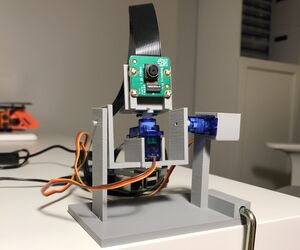
Web Controlled Camera Turret
"In this instructable I will walk you through the steps on how to make a a servo-driven turret with a raspberry pi camera module, which you control over the web. Use it to spy on your cat or keep an eye on the kettle when you leave the room or any other situation where you need a third eye. This is a fun and fairly beginner friendly introduction to servo-control with raspberry pi, servers, html, php and databases. It requires little to no prior knowledge on any of the mentioned subjects but will hopefully spark your interest and encourage you to learn more on those topics. I will however assume you are a bit familiar with the raspberry and have used the camera module before, if not, check out a tutorial on how to set up and use the camera before starting this project. I have used some 3D-printed parts for the turret (links are provided to STL-files) but if you dont have access to one of those, I will explain how you can make this project anyway." [...]
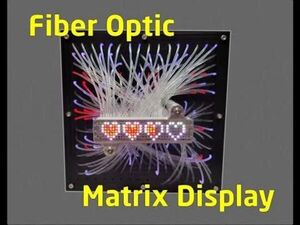
Fiber Optic Matrix Display
"Behold! This is a 35x7 RGB matrix display powered by a Raspberry Pi Pico and a bunch of WS2812B LEDs (Neopixels). I've never see anything quite like it on the internet before, hopefully I'm the first! The display is a bit absurd, as it takes a much larger grid of LEDs (64 square inches) and condenses them down to a much smaller size (1.5 square inches). In this instructable I will discuss how I constructed this and provide you with everything you need to make one of your own, but I encourage you to take this concept and come up with your own design. They key ingredients that make this work are: 16x16 WS2812B matrix." [...]

DIY Split-Flap Display
"Split-flap displays are electromechanical display devices, which were common in airports or railway stations a few years ago.Unfortunately, most of them are gone and replaced by LED displays. Why not create a DIY version of it? As mechanical devices they are rather complex and subject of mechanical wear-out. But Split-Flap displays have many advantages over their LED counterparts: no power required if the display is static, good visibility and contrast, and the flapping sound draws attention if information changes. " [...]
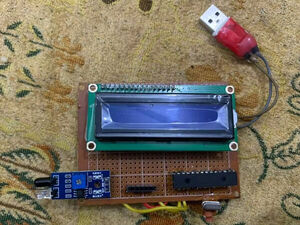
Tachometer
"This Tachometer very precise. it measures too fast or slow RPMs and it can be used to measure engine RPM or any thing. I am currently making an electric Bike, but the problem is that I wanted to measure the RPM of the electric motor. I searched for DIY tachometers online but they didn't work :(, so I decided to make my own. Its principal is very easy ; it uses IR Sensor to detect every rotation and then the microcontroller counts the time it took to complete 20 revs and then divides the number of revs over the time it measured and finally multiply it by 60 to give us RPM aka revolutions per minute. " [...]
Secção Videos
Videos interessantes.
That's all Folks!



